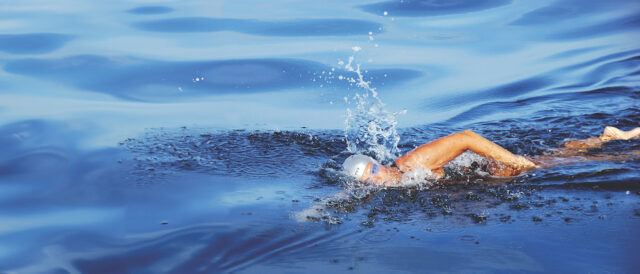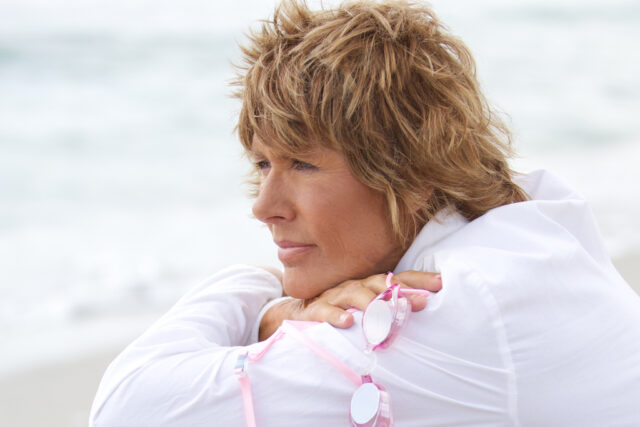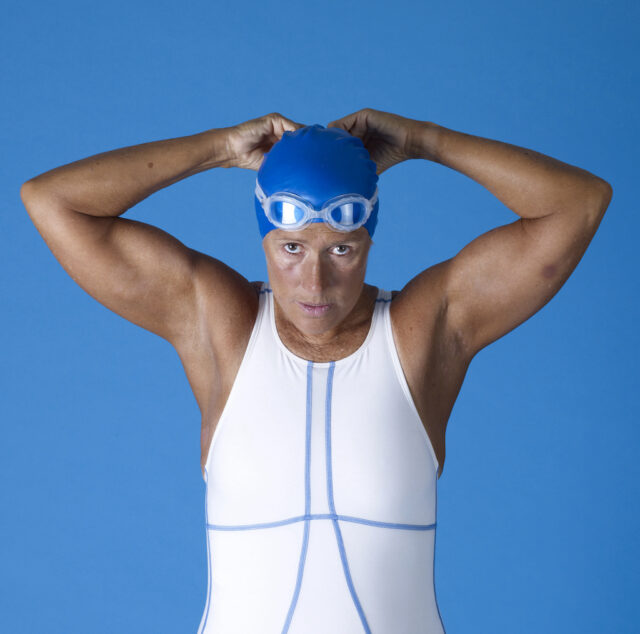
By Ray Rogers
Beyond her awe-inspiring metronomic stroke and fierce athleticism, it is Diana Nyad’s ironclad will and dogged tenacity that led her to achieve her dream of conquering a shark- and jellyfish-infested 110-mile stretch of open seas from Havana, Cuba, to Key West, Florida, on her fifth attempt, at the age of 64. Her unstoppable resolve has inspired people of all ages the world over.
The subject of last year’s Netflix biopic Nyad, starring Annette Bening and Jodie Foster, she’s been telling her own story for decades. Her first memoir, Other Shores, written at age 30, came out in 1978. A reprint of 2015’s Find a Way, completed at age 65, is out now. It charts her journey in compelling and charming detail, with remarkable candor and wit. She’ll be at this year’s Authors Night on August 10 at Herrick Park in East Hampton to greet readers and sign copies. Nyad took time out from a global speaking tour to talk with Purist in advance of her engagement at Authors Night.
Ray Rogers: Since you are participating in Authors Night in East Hampton, let’s begin by talking about writing and the power of storytelling—having a voice and finding and owning that voice. What was that process like for you when you first began to write, and how has it evolved when you came to write Find a Way and then your play, The Swimmer?
Diana Nyad: For me, writing intertwines with the spoken word. I’m a writer who writes with a speaking voice. People often tell me, “I can hear you.” Does that make it better? You probably wouldn’t want to hear Faulkner—you really want to read Faulkner. But for me it begins with the spoken word, and that started very young, before age 10. I was always writing essays and articles and also speaking them—getting onstage and speaking sort of off the cuff. The writing has that kind of oral history voice. I really enjoyed reading the audiobook, by the way. A lot of people don’t read their own books, especially nonfiction writers. They get actors who have terrific accents and voices and project it. I did very much enjoy doing it. There’s a lot of singing. There’s even whistling, which is frankly my biggest talent.
If you go all the way back in the history of man and womankind, the very first art we made and stories we told were in caves—just chiseling away the animals and the children in our lives on the walls of caves and sitting around the proverbial campfire telling stories. There’s always the best storyteller. I don’t care whether you go into a tribal village or whether you’re in the city of London, every family, every classroom—we know who the best dancer is very quickly. We know who the best singer is. We know who the best athlete is. And very quickly you know who the best storyteller is. All my life I’ve been asked to speak at friends’ funerals and weddings and birthdays because I can tell a story. I’ve been doing this all my life, and now with the Netflix movie out, I’m going all around the world again, happy to stand up and hopefully entertain and inspire people. But it’s all about storytelling for me. I’m not a lecturer. I don’t stand with a whiteboard and say well, the five elements of success are this and this. I tell a story and take you with me. There are people who are memoirists—Jane Fonda is one—who have lived interesting, intricate, long lives and they write many memoirs, not just one. I wrote one at the age of 30, and now I look back with horror to think that I knew anything at the age of 30. There’s some storytelling, but I’m spouting off about the meaning of life and what we should all do and what makes a good life. I will never go back and open that book again.
Truthfully, I finished this book at age 65, it was 2015, and now 10 years later, I’ll be 75 just after Authors Night. I feel very vital and energetic and fit and mentally ready to take on the world. But let’s face it, you know more at 75 than you did at 30 and even at 65. I’m sure that I’ll talk to you when I’m 85 and say what an idiot—I thought at 75 I really knew what life was all about.
RR: What were you like as a child? You mentioned you were always a strong storyteller.
DN: Here’s a quick story. I was at my sixth grade graduation and we had a class speaker. I was sitting with my mom. I had my little black patent leather shoes—this is in Fort Lauderdale, Florida—and the principal came and he was urgent and he bent down next to me and said, “Diana, Jimmy Woodruff is vomiting violently in the bathroom. He can’t do it. He’s our class speaker. He can’t get off his knees. He’s retching.” And my mother looked at me in alarm like well, what are you supposed to do about it? He said, “Could you give us a few minutes. We don’t have a class speaker.” My mother yanked me over to the side and said, “Don’t you dare. You have not prepared anything. You’re going to make a fool of yourself. All the teachers, the coaches, the parents—they’re all here and they’re all going to remember what a fool you made of yourself.” I turned back to the principal and said, “What were you thinking—five minutes, seven minutes?” He said, “It doesn’t matter. If we could get you to say anything it’ll be OK.” So, I stood up and looked around and said “OK. We’re 11. Let’s just say we’ve been doing our best. But if you look at all our grandparents’ ages combined, probably most of us are going to live another 70 to 80 years. Maybe we really haven’t been doing our best. What are we going to do? Are we going to dig down? Are we going to become doctors and help people? Are we going to learn foreign languages and travel the world and help the poor people? Are we going to be everything we can be? Because we can do better than we’ve done at age 11.” When we went home that night my mom said, “I will never stop you from speaking out loud and telling your stories again.”
RR: Stories are how we understand ourselves, our place in the world and the world around us.
DN: I’m sure that all these wonderful authors who attend this prestigious event feel like I do. Yes, I’m honored to come there as an author, especially since my book is a reprint this year because of the movie. But I’m coming as a reader as well. When I look down the list of whether it’s fiction or nonfiction, these are eminent people on the written page and thinkers. I just can’t wait to mix in with them and buy all their books and get home and spend the rest of my summer reading them.
RR: Are there any in particular you’re wanting to meet?
DN: Yeah, I want to read and meet Neil deGrasse Tyson. Since I’ve been a teenager I’ve been reading Cosmos. Carl Sagan is a god to me. Nobody will ever replace Carl Sagan. I’m just rereading Cosmos right now. Every sentence blows your mind, but he was a real philosopher and a poet. Nevertheless, Neil deGrasse Tyson has become the interpreter of space and the history of space and the future of space for we, the laymen. I just find him terribly imaginative. I’d also like to meet Maggie Haberman. I mean nobody boils down politics in this crazy era like Maggie Haberman.

RR: That’s what’s so great about this event: Authors and readers get to interact with each other.
DN: Honestly, I’m thrilled to be included. It’s a privilege.
RR: I love that a big part of your book is celebrating this truly great friendship with Bonnie Stoll (her lifelong friend and coach, portrayed by Jodie Foster in the movie) and the teamwork and the spirit of that. Was that very intentional for that to be a big part of your storytelling—the power of friendship and teamwork?
DN: It’s just a real part of life, and it’s a real part of my life. A friend, to my mind and in my life, is equally important—if not more so—than blood family. I dedicated the book to my two best friends. Bonnie is highlighted in the movie because she was the head of the expedition in the modern day. But back in the ’70s, Candace Lyle Hogan, who is my other best friend whom I’ve actually known longer than Bonnie, was then my head handler on the boat. She’s the only person who was on the boat all five times from 1978 up to 2013. So, I have these two best friends and I forget the exact expression, but if you’re lucky enough to have one good friend in this life, one lifelong friend who trusts you, whom you trust, whom you’re there for every single day, who is No. 1 in your life, then you have found true great fortune. Well, I have two, and I try to make that clear in the book. Candace—it’s taken a strong personality to withstand being completely left out of the movie. But that’s how movies are.
RR: It also takes tremendous courage in telling the more challenging and traumatic parts of our stories. I’m talking about the abuse that you suffered. I want to thank you for highlighting that, because it’s meaningful to so many people to hear that they’re not alone.
DN: Well, thank you. You know, I’m not quite sure how to go about it but the whole last year I’ve been mulling over how to start an archive. What should it be? Would it be a website? Would it be a YouTube channel? I don’t know. But I’d like to start an archive for survivors of sexual abuse, to provide a place for people to have their voice, to speak out on video, to be anonymous or to name themselves.
I do know that there is tremendous power in speaking out. It’s such a situation of shame and of silence as a young person to be abused by someone you love and admire, which is my case, and it’s the case of many. You start taking the power away from that person, and away from what happened to you when you speak the words and you make it more concrete. Of course, I wasn’t going to be shy and leave that out of the book. It’s part of my history. I wish it weren’t. and I’d like to say that oh, here I am almost 75 and that was a long, long time ago. It’s way in the rearview mirror. All that’s true, but the shame and the anger still will flare up every now and then. It never goes away. You never outlive it or outrun it. Speaking it out and writing it out is crucial to people who have gone through that trauma.
RR: There are some lighter parts of your story that I wanted to talk about. I’m such a music guy, so I especially love these details of singing Roy Orbison’s “Blue Bayou” 200 times to mark distance or time, or “Me and Bobby McGee”—what a fabulous detail. Is that something you still do?
DN: Oh, yeah. All the time. That’s how I get through any long workout. In swimming, you’ve got this metronome of a stroke. You’ve got a stroke that’s been keyed in all your life and once you get going, once you get in a rhythm you know how many strokes per minute, how many strokes for 15 minutes, how many strokes per hour. If press came on our boat, Bonnie would say to them, ”We’re going to do a 14-hour swim.” I do pause for little feedings, but not counting those, she would stop me and say, “Diana, what time is it?” I’d yell out it’s 1:22, because I’ve been counting and I know exactly what time it is without looking at a clock, and you vaguely know where the sun is. But I could know because I’m counting. And the songs, I’d measure them out, so I know how long Janis Joplin’s “Me and Bobby McGee,” the entire song is, note for note, I know how long it takes and I know how long it’s going to take if I sing it a thousand times in a row.
If I’m out there swimming through two nights, those songs help me get through them in a big way. You’re not allowed to wear headphones in the sport. Part of the sport is the discipline of your mind as much as the discipline of your body. And Netflix, I could just kiss those people. They spent a fortune licensing those songs, because Roy Orbison, Simon & Garfunkel, and Neil Young, they cost a fortune, but Netflix knew they were important to me. When I first saw the movie, Annette Bening, if you remember, she’s in a pool, doing a long day and night swim, singing Simon & Garfunkel. After a couple of lines with her voice, they bleed in the Simon & Garfunkel: “Hello darkness, my old friend.” I just wept. Those are the songs. That was the emotion that helped me through, especially the nights.

RR: What was it like to see your story up on screen portrayed by such kick-ass actresses?
DN: It just doesn’t get any better, does it? Years ago when there was no Netflix yet, there was no money, I chose an executive producer named Andrew Lazar, in part because he was in love with my story and admiring of me as an “epic personality.” I’m using his words, not mine. And he’s in love with the ocean as well. He’s a big-time big-wave surfer. So, he and I were together and Bonnie, too, but we’d sit around saying of all the preeminent actresses today—and they’d have to be of a certain age—who would be best to play me? It was always Annette Bening. You could go to Meryl Streep and Charlize Theron and Sandra Bullock, fierce actresses. They could all do it, but it was always Annette Bening. And once Annette Bening signed, Jodie Foster signed 24 hours later. They had always wanted to work together. They had both followed the story in real time in the news and they were both intrigued by it, by the friendship, by the power of a woman doing this and two women doing this. So, it was magical to have them.
It’s not a documentary, so it’s not going to be exactly the story, but what I had to concede is that it’s their movie. It’s that writer, those producers and those directors. It’s their movie, and they asked Annette Bening to play the script the way they wrote it. She’d be the first one to say that the character she played is not as likable, not as charismatic, as I am in real life. But I would go with that very quickly given that they were playing the movie, and the movie captured my friendship with Bonnie, and put on glorious display an unapologetic pursuit of a dream: “No matter what happens, don’t tell me I can’t do this. I don’t care what you think. I’m doing this.” And they captured all of that essence. Listen, they named the movie after my name. How often does that happen? So, believe me, I can let go of any little hurt feelings I had that I wasn’t as likable and friendly as I really am. And that I didn’t know my team, and I wasn’t kind of a visionary who poured the Kool-Aid that they all drank. I was that person in real life, and my teammates were kind of left out of that story except for John Bartlett, the navigator. That’s part of Hollywood, and as I say, It’s their movie. I’m good with all of that. They could joke that they usually make biopics about people who are dead because they’re not around to complain about what’s being done with their story. But believe me, I am so honored. I’m so proud of this movie.
RR: It’s hugely inspirational. Has your life changed at all since the movie came out?
DN: No, I think I’m too grounded. My values have been set. My speaking career has fired back up again, but that’s a superficial thing. When the real swim happened in 2013, for five years I just flew around the world telling my story, getting up in front of audiences and hopefully inspiring them. Then it tapered down. I was still speaking up until COVID time, and then that became a virtual situation rather than with real-life audiences. But now with the movie, it has swollen back up again. I’m leaving for Barcelona tomorrow and after that, many different places.
RR: There’s a part of The Swimmer where you’re talking about being in a state of crisis or semicrisis most of the time while you’re in the swim, but still being able to find moments of beauty and appreciating the majesty of the sea and being in awe of the blue jewel of this planet. That’s a great reminder for anyone going through anything in life: Don’t forget to take in the beauty surrounding you no matter what you’re going through. Is that something you’ve always been able to do?
DN: Yeah, I think so. I mean it’s a sport that’s very easy to get pulled into all the tough stuff. You don’t finish any marathon swim and say god, that was a great time. Wow, it was just sheer joy out there. But that doesn’t mean that there aren’t moments of joy. I’ll never forget that enrapturing feeling of being 50 to 60 miles offshore, looking up you can see 2 billion stars literally on a clear night in summer in the Gulf Stream. So, there’s this feeling of traveling across the curvature of the Earth with your own steam. You’ve worked that hard that you can actually travel. People are excited to be with you, traveling with you to do something no one’s ever done. All of that was enrapturing. I can’t speak for people who have the bad luck to be going through cancer. I can’t say come on, buck up. OK, you’ve got Stage 4 breast cancer, but can’t you just look up at the blue sky and appreciate planet Earth? I can’t say that to anybody who’s really dealing with dire, dire straits. I think for most of us, we know what heartache is and we know even what suffering is, and even though it’s part of the human condition, to also find gratitude and appreciation and see the beauty around us and look into our dog’s eyes and feel the love. I know I can always do that, but I’ve never been at war, and I’ve never been down with a terrible disability or disease.
A man just wrote to me, a pretty badass guy who ran all the way across America twice, finished many Ironman [races]. I think he’s done 14 or 16. But five years ago— he’s now 52—he was diagnosed with Parkinson’s disease, and he writes to me to say that he’s losing ground almost daily. Now he’s humiliated. He can’t unzip or zip his pants. His wife has to help him go to the bathroom. I mean, it’s tough. But he said to me, “You know what? I read your book and I saw your movie and I can’t be all I was going to be. I can’t be all I was, but I can be everything I can be. I want that to be enough. I want that to excite me that I have this disability, and I don’t want to focus on what I can’t do and what I will never do. I want to focus on what I can do and be everything I can, and not put a definition on well, it’s not very much. It’s a lot.”
So, I wrote him back, and we had a couple of back and forths. He’s writing a book and he’s a brave guy. Honestly, when people compare me to going to war or going through something like that, it’s nowhere like it. It’s a sport, and you choose to do it. I don’t like to ever pretend I’m in that category with people.
RR: What would you like your legacy to be?
DN: Let’s come full circle in our conversation. I think that there’s no doubt that I will be known as one of the better and tougher endurance athletes of our time. I loved that when I finished the swim, ESPN put a graphic up on their screen and ran it for about 48 hours that said the toughest athlete in the world today is a 64-year-old woman. So, that’s a nice legacy to carry with you, to be tough and to never give up and to inspire other people. But I’d like to be known as one of the better storytellers of our time as well.
East Hampton Library’s 20th annual Authors Night takes place on Saturday, August 10, at 5PM at Herrick Park, East Hampton Village; authorsnight.org





